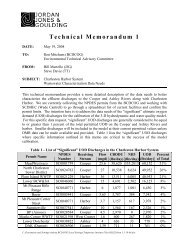Town of Summerville Planning Area - BCD Council of Governments
Town of Summerville Planning Area - BCD Council of Governments
Town of Summerville Planning Area - BCD Council of Governments
- No tags were found...
You also want an ePaper? Increase the reach of your titles
YUMPU automatically turns print PDFs into web optimized ePapers that Google loves.
Transporation Improvements – Roads Table identifies tools the <strong>Town</strong> <strong>of</strong> <strong>Summerville</strong> should pursue throughpartnerships with Dorchester County to establish and generate funding sources for transportation projects. Themunicipal boundaries <strong>of</strong> the <strong>Town</strong> <strong>of</strong> <strong>Summerville</strong> and unincorporated Dorchester County are closely tied andinterwoven thus further advancing the necessity <strong>of</strong> inter‐governmental coordination across municipalboundaries.Dorchester County voters approved a one‐cent sales tax in 2006 thus enabling the Dorchester County PennySales Tax Authority (DCTA) to enact a program including 22 road improvement projects with a timeline <strong>of</strong> five toseven years. The project revenue <strong>of</strong> $125‐million dollars will be combined with funds available to DorchesterCounty from the South Carolina (SCDOT), Federal Highways Administration (FHWA), private contributors andother sources (DCTA, www.dorchesterroadstax.org, 2007).The <strong>Town</strong> <strong>of</strong> <strong>Summerville</strong> and Dorchester County are members <strong>of</strong> the Charleston <strong>Area</strong> Transportation Study(CHATS). CHATS is the regional transportation‐planning authority for the urbanized portion <strong>of</strong> the Charleston‐North Charleston Metropolitan Statistical <strong>Area</strong> (MSA). Federal funds for transportation infrastructureimprovements are channeled through CHATS and the Berkeley‐Charleston‐Dorchester <strong>Council</strong> <strong>of</strong> <strong>Governments</strong>(<strong>BCD</strong>COG). Dorchester County applied to the State Infrastructure Bank (SIB) in December 2007 for financialassistance with five major road improvement projects. Although the funding timeline has not been finalized,the SIB committed $213.2 million dollars to Dorchester County.Alternative funding sources for transportation infrastructure improvements should be considered by the <strong>Town</strong><strong>of</strong> <strong>Summerville</strong> by assessing “transportation impact fees.” The Dorchester County comprehensive land use planrecommended “transportation impact fees” to fund transportation infrastructure improvements. To assure auniformed transportation strategy throughout geographic Dorchester County, it’s essential the <strong>Town</strong> <strong>of</strong><strong>Summerville</strong> consider pursuing similar lines <strong>of</strong> funding sources for these transportation improvements.Dorchester County has commissioned Kimley Horn & Associates, a transportation planning firm, to compile acomprehensive transportation plan for Dorchester County. The <strong>Town</strong> <strong>of</strong> <strong>Summerville</strong>’s Transporation Planconducted by Carter & Burgess is discussed in the Transporation Design Element. The <strong>Town</strong> <strong>of</strong> <strong>Summerville</strong>should consider the potential <strong>of</strong> conflicting public policy regarding funding mechanisms for transportationimprovements in the event that transportation impact fees are adopted by Dorchester County. These itemsshould be addressed by the <strong>Town</strong> <strong>of</strong> <strong>Summerville</strong> during the composition <strong>of</strong> their Transporation Impact FeeStudy being conducted by Kimly Horn and Associates.Prior to implementing transportation impact fees, the <strong>Town</strong> <strong>of</strong> <strong>Summerville</strong> should amend their CapitalImprovements Plan to identify plans for expansion <strong>of</strong> transportation infrastructure throughout the <strong>Planning</strong><strong>Area</strong> over the next five to ten years. The <strong>Town</strong> <strong>of</strong> <strong>Summerville</strong> should confirm a “rational nexus” (Nolan v.California Coastal Communities, 483 U.S. 825, 1987) exists between the assessed transportation impact fees andthe impact projected from the new development or user.Impact fees can provide a counter balance <strong>of</strong> the proposed development or new user on existing infrastructure.The fees collected from a new user on the transportation network should benefit that user, as opposed t<strong>of</strong>unding a transportation improvement project in another location <strong>of</strong> the municipality in which the user has nodirect impact. Impact fees are determined based upon the cost <strong>of</strong> new facilities relative to the size, proportionand demand a new proposal has on the facility.Transportation impact fees redirect the construction costs <strong>of</strong> new public facilities from taxpayers to theimmediate beneficiaries <strong>of</strong> those facilities. The <strong>Town</strong> <strong>of</strong> <strong>Summerville</strong> may combine revenue from transportationimpact fees with other local funding sources to accelerate major infrastructure and facility improvements.Special consideration should be made to address future land use planning issues in order to direct new growthand development towards the newly constructed public facilities.p Priority Investment <strong>Area</strong>s Element Page 5




